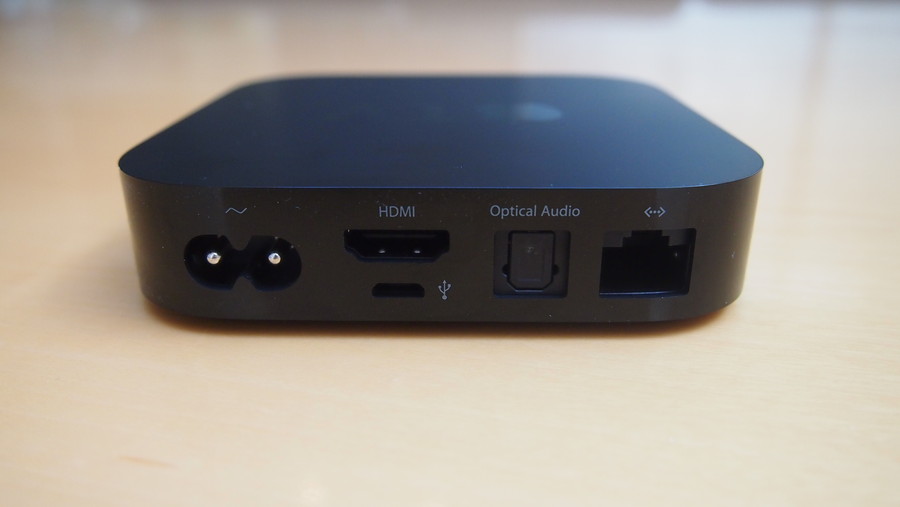Apple TV Reviewed through the eyes of AcuZon (Pg. 02)
What’s in the box of ATV?
The ATV comes with a power cable, a setup guide and a nice looking aluminum finish remote control. The box does not include any HDMI cables. However, as part of AcuZon’s offering, we provide the HDMI cable based on the setup required in terms of length and type, we also provide optical audio cables if necessary. The setup guide won’t be necessary as we pre-configure the device for you before we dispatch it.
THE ATV DEVICE
The device itself feels like a solid piece with a decent weight and has a nice grip when placed on flat surfaces due to the rubber base at the bottom. At the back, there are five different ports for power, HDMI, Optical Audio, RJ45 jack for wired Ethernet and a Micro USB. The Optical Audio is to be used for direct connectivity to Amplifiers and Home Theatre Receivers. The Micro-USB port is to be used for diagnostics and hardware re-initialization which will not be required in a configured device. The Ethernet port is a 100Mbit which is a petty, but it seems the gigabit wired connectivity is not a necessity as of now given that the bandwidth required to stream full HD content is way less than that. There is a Wi-Fi module embedded in the device with (802.11a/b/g/n). Having the N range in the Wi-Fi is a key feature due to its bigger range and faster data transfer. The device has a Bluetooth module as well used to connect with Apple Wireless Keyboard for faster data entry.
THE REMOTE
The Remote feels good in hand, it is light and small and seems to be intuitive without the need to look into the buttons every time you want to send commands to the device. The remote can work with multiple ATVs but may also be paired to work only with one ATV. This kind of setup may present a key advantage when multiple ATVs are available in one house. We can setup any sort of arrangement based on request. It is also worth noting that the Remote works with MacBooks as well to raise/lower volume and play/stop iTunes Content. The signal is sent over IR between the ATV device and the Remote which sometimes might create problems due to the required line-of-sight between the device and the Remote. IR is necessary to ensure unpaired connectivity between multiple remotes and multiple ATVs. Beyond the standard commands sent through the buttons in the remote there are combination of button presses that can be used for sending specific commands for diagnostic reasons.
For Data Entry while searching within applications, for instance, there is a virtual keyboard that opens up whenever there is text input required. Text input through this virtual keyboard is troublesome and takes some time to get used to, but Apple has added the options to use their Wireless Keyboard to have an easier text entry experience. Having said that, Arabic text entry still remains a challenge which is doable using the REMOTE App in iOS devices (such as iPhone, iPad & iPod). The REMOTE App functions as a full remote for the ATV which becomes handy when the physical remote is out of reach. In AcuZon, we offer you the keyboard with its configuration as well as training on how to use it. Also, we offer you the REMOTE App setup and training if you happen to own a iOS device.
USES OF ATV IN LOCAL NETWORK
Even though ATV is a stream only device it does not necessitate that you have to stream all your data through the internet. There are multiple uses for the ATV to view content from your local network. This can be arranged through a centralized Media Server or multiple Media Servers depending on the setup you have in your home (for example streaming content from multiple computers in your home network, one belonging to each member in the house). In AcuZon, we offer you media servers, help you convert you network connected computers into media servers, and design your network to allow for local streaming option to work.
However, one must note that the content has to be iTunes/ATV friendly for it to function. Below details collected from Apple Support (2013):
Video Formats:
- H.264 video up to 1080p, 30 frames per second, High or Main Profile level 4.0 or lower, Baseline profile level 3.0 or lower with AAC-LC audio up to 160 Kbps per channel, 48kHz, stereo audio in .m4v, .mp4, and .mov file formats
- MPEG-4 video up to 2.5 Mbps, 640 by 480 pixels, 30 frames per second, Simple Profile with AAC-LC audio up to 160 Kbps, 48kHz, stereo audio in .m4v, .mp4, and .mov file formats
- Motion JPEG (M-JPEG) up to 35 Mbps, 1280 by 720 pixels, 30 frames per second, audio in ulaw, PCM stereo audio in .avi file format
Audio Formats:
- HE-AAC (V1), AAC (16 to 320 Kbps), protected AAC (from iTunes Store), MP3 (16 to 320 Kbps), MP3 VBR, Audible (formats 2, 3, and 4), Apple Lossless, AIFF, and WAV; Dolby Digital 5.1 surround sound pass-through
Photo Formats:
- JPEG, GIF, TIFF
Apple Support (2013)
This creates a number of difficulties given the level of complications tied with converting the data to be ATV acceptable. Therefore, in AcuZon we offer you a package add-on to train you on how to convert your media to become within the standards required by ATV shown above. This way you can make sure that all you legally downloaded video content and the home videos you shoot are viewable on your ATV.


